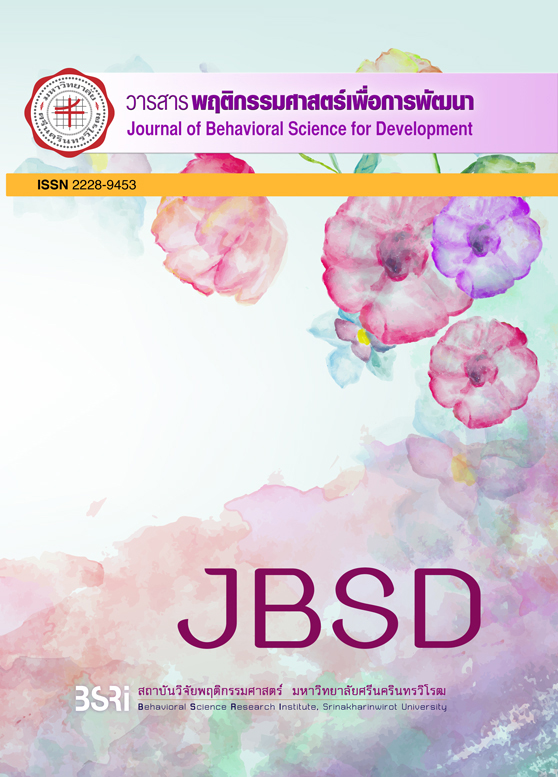A Development of Preventive Program Increase Protective Outcomes and a study of Preventive Effects on Smoking Intention among Secondary School Students
Abstract
การพัฒนาโปรแกรมเพื่อเพิ่มผลลัพธ์เชิงป้องกันและการศึกษาผลของโปรแกรมที่ส่งผลต่อเจตนาเชิงพฤติกรรมการสูบบุหรี่ของนักเรียนชั้นมัธยมศึกษาตอนต้น
Abstract
The purposes of this research aimed to develop the preventive program for increasing the protective outcomes and to study the effects of the preventive program on the smoking intention of secondary school students. The developed prevention program is based on previous model of youth smoking intention combining four concepts: rationale, development, social norms, and social reinforcement. The developed preventive program consisted of 8 activities for skill learning which were divided into three sections: the strengthening of knowledge about tobacco and substance, enhancing social skills, and enhancing intrapersonal skills. The program including content area documents, media, learning activities, and games was organized once a week for 10 weeks, each of which took approximately 50 minutes. The protective variables included goal directed future orientation, negative attitude toward smoking, negative prototype, and peer resistance efficacy were tested as indicators of students’ protective factors. A pretest posttest control group design was applied to this study and the preventive program was tested with 258 secondary school students divided into an experimental group and control group. Data were collected by questionnaire and measurement variables with reliabilities range between 0.85 to 0.95 Structural equation modeling was used to evaluate the predictive power of the variables pathway. The goodness of fit statistical analyses indicated that the causal model of smoking intention was best fit to the empirical data. Findings indicated that preventive program was associated with smoking intention indirectly through protective factor, and protective factor was partially mediated the relation between preventive program and smoking intention. Structural equation modeling also revealed a model form consistent with previous research generated by the Youth Protective Factor Model. All independent variables in the tested model explained 61 percent of the smoking intention of secondary school students. The application of this prevention program appropriateness for the school context and a study in long-term effectiveness of school-based smoking prevention programs are needed.
Keywords: Smoking Intention, Preventive Program, Adolescence
บทคัดย่อ
การวิจัยครั้งนี้มีวัตถุประสงค์เพื่อพัฒนาโปรแกรมเชิงป้องกันในการเพิ่มผลลัพธ์เชิงป้องกันและศึกษาผลของโปรแกรมเชิงป้องกันที่ส่งผลต่อเจตนาเชิงพฤติกรรมการสูบบุหรี่ในนักเรียนชั้นมัธยมศึกษาตอนต้น โปรแกรมเชิงป้องกันที่พัฒนาประยุกต์แนวคิดกลุ่มหลักการและเหตุผล กลุ่มการรับรู้ทางสังคม กลุ่มพัฒนาการทางสังคม และกลุ่มการเสริมแรงทางสังคม โปรแกรมเชิงป้องกันประกอบด้วยการเรียนรู้ทักษะ 8 ครั้ง แบ่งกิจกรรมเป็น 3 ช่วง ได้แก่ การเสริมสร้างความรู้ (knowledge) การเสริมสร้างทักษะทางสังคม (social skills) และการเสริมสร้างทักษะในตนเอง (intrapersonal skills) โดยมีอุปกรณ์ เอกสารเนื้อหา สื่อ กิจกรรม และเกม โดยใช้เวลาสัปดาห์ละ 1 ครั้ง เป็นเวลา 10 สัปดาห์ แต่ละครั้งใช้เวลาประมาณ 50 นาที ตัวแปรเชิงป้องกันประกอบด้วยการวางเป้าหมายมุ่งอนาคต การต้านทานอิทธิพลกลุ่มเพื่อน เจตคติทางลบต่อการสูบบุหรี่ในวัยรุ่น และการรับรู้ภาพลักษณ์ในทางลบต่อวัยรุ่นที่สูบบุหรี่ กลุ่มตัวอย่างที่เข้าร่วมวิจัยเป็นนักเรียนระดับชั้นมัธยมศึกษาตอนต้น จำนวน 258 คน แบ่งเป็นกลุ่มทดลองใช้โปรแกรมและกลุ่มควบคุม มาตรวัดคุณลักษณะต่าง ๆ ของนักเรียน ได้แก่ มาตรวัดการวางเป้าหมายมุ่งอนาคต มาตรวัดการต้านทานอิทธิพลกลุ่มเพื่อน มาตรวัดเจตคติทางลบต่อการสูบบุหรี่ในวัยรุ่น และมาตรวัดการรับรู้ภาพลักษณ์ในทางลบต่อวัยรุ่นที่สูบบุหรี่ มีค่าความเที่ยงระหว่าง .85-.95 ใช้การวิเคราะห์โมเดลสมการโครงสร้างเชิงเส้นในการประมาณค่าเส้นทางอิทธิพล พิจารณาค่าสถิติความกลมกลืนที่บ่งชี้ถึงความสอดคล้องกลมกลืนของโมเดลการวิเคราะห์กับข้อมูลเชิงประจักษ์ ผลการศึกษาที่สำคัญพบว่าโปรแกรมเชิงป้องกันมีอิทธิพลต่อเจตนาเชิงพฤติกรรมการสูบบุหรี่ทั้งทางตรงและทางอ้อมผ่านปัจจัยป้องกัน ทั้งนี้ปัจจัยป้องกันทำหน้าที่เป็นตัวแปรส่งผ่านความสัมพันธ์ระหว่างโปรแกรมเชิงป้องกันและเจตนาเชิงพฤติกรรมการสูบบุหรี่ในนักเรียน นอกจากนี้ผลของโปรแกรมเชิงป้องกันยังส่งผลต่อเจตนาเชิงพฤติกรรมการสูบบุหรี่ในวัยรุ่น โดยมีปัจจัยป้องกันเป็นตัวแปรส่งผ่านสอดคล้องกับโมเดลปัจจัยเชิงป้องกันในวัยรุ่นที่ทำการศึกษาก่อนหน้า ตัวแปรในโมเดลอธิบายความแปรปรวนในตัวแปรเจตนาเชิงพฤติกรรมการสูบบุหรี่ในนักเรียนคิดเป็นร้อยละ 61 การประยุกต์ใช้โปรแกรมนี้จึงมีความสอดคล้องกับบริบทของโรงเรียนที่ทำการศึกษา ทั้งนี้การศึกษาผลกระทบระยะยาวของโปรแกรมเชิงป้องกันในบริบทของโรงเรียนเป็นฐานจำเป็นต้องได้รับการศึกษาวิจัยอย่างต่อเนื่องด้วย
คำสำคัญ: เจตนาเชิงพฤติกรรมการสูบบุหรี่ โปรแกรมเชิงป้องกัน วัยรุ่น




